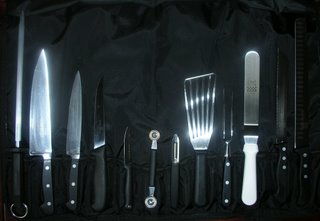GLOWING LIKE THE METAL...

Before getting ahead of myself any further, let's introduce the tools of the trade. These tools were all provided to us by the school as part of our tuition. Some of the students in my class have already upgraded their knives at some of the local stores, Sur La Table and Broadway Panhandler. But I'm going to wait a little while and learn to use the standard-issue knives and do some comparison shopping before I buy a new knife.
From left to right:
1) Steel, used for sharpening knives
2) Chef's knife, used for cutting whatever, whenever
3) Bone knife, used for cutting meats, etc.
4) Fish boning knife, used for boning and filetting fish
5) Pairing knife, used for peeling fruits and vegetables
6) Melon-ball scooper, used for scooping out melon, apple, cores, etc.
7) Peeler, used for peeling skins off fruits and vegetables
8) Fish spatula, used for lifting, flipping fish filets
9) Meat fork, used for moving, piercing, picking up meat
10) Offset spatula, used for spreading things like tuile, or frosting
11) Serrated knife, used for slicing meat
12) Bread knife, used for cutting breads, cakes, etc.

Again, from left to right:
1) Wooden spoon, for stirring sauces, etc.
2) Microplane, for shredding cheese, rinds, etc.
3) Scissors, for cutting fish fins and whatever needed.
4) Pastry-scraper, for scraping dough, sabler, etc.
5) Pen, always have one!
5) Pastry-brush, for brushing on butter, oil, syrups.
6) Small offset spatula, smaller version of # 10 (above)
7) Trussing needle, for sewing meats
8) Tweezers, for picking out fishbones
9) Thermometer...
10) Teaspoons, tablespoons
11) Fireproof spatula, for getting every last bit!
 On the Left:
On the Left:1) Metal pastry-scraper, for scraping dough, sabler, etc. (bought on own
2) Canneleur, for decorating vegetables
3) Large spoon, for skimming and degreasing
 On the Right:
On the Right:1) Pad, for recipes
2) Pens, hilighters and sharpies
Recipes should be written out as easily followed as possible. The easiest we've been taught is to notate the ingredients and how they are used in the order to be used. This makes for memorizing both ingredients and methodology easier.

TASTING SPOON: The chefs have what they call, their "sexy spoon," which they use for tasting and and other spoon "emergencies." One chef even has such a spoon engraved, "Chef XXNamehereXX's Sexy Spoon," (there are rumors about this chef...) with the date. You should always have spoons around for tasting (as you're not supposed to be dipping your fingers in pots). Of course, you can use any old spoon. In Level 1 we were encouraged to taste each others' dishes to get an idea of how the same dishes, based on standard recipes, can come out differently when cooked by different people. I wasn't shy about doing this and one of my teammates suggested that with all the tasting I was doing, I should get a golden tasting spoon.





0 Comments:
Post a Comment
<< Home